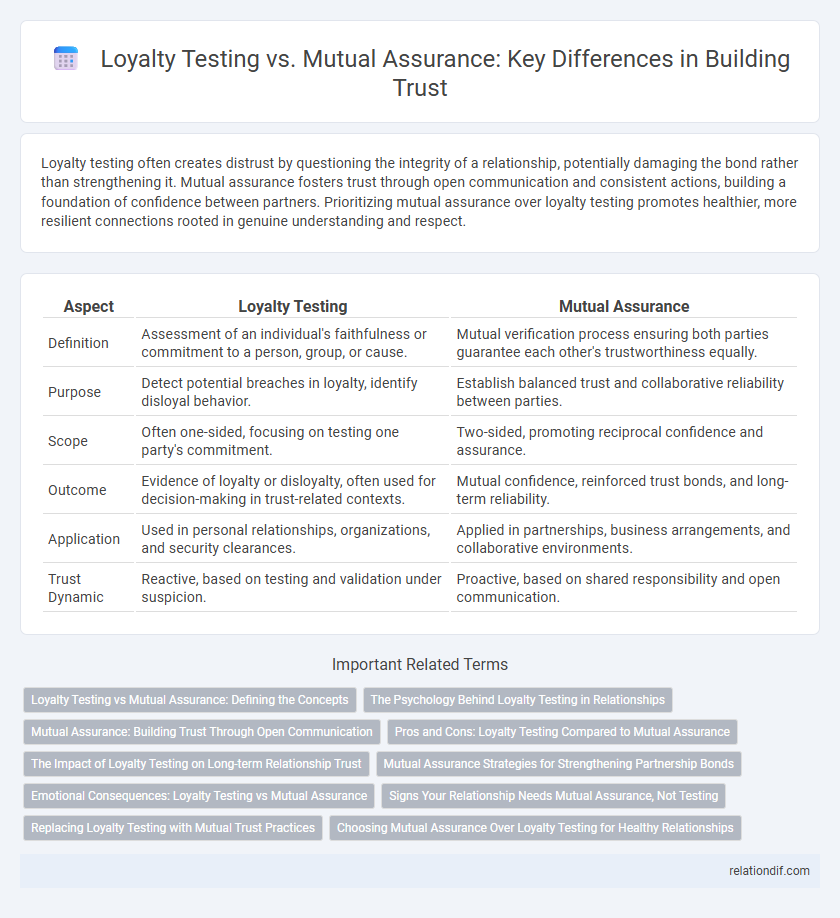Loyalty testing often creates distrust by questioning the integrity of a relationship, potentially damaging the bond rather than strengthening it. Mutual assurance fosters trust through open communication and consistent actions, building a foundation of confidence between partners. Prioritizing mutual assurance over loyalty testing promotes healthier, more resilient connections rooted in genuine understanding and respect.
Table of Comparison
| Aspect | Loyalty Testing | Mutual Assurance |
|---|---|---|
| Definition | Assessment of an individual's faithfulness or commitment to a person, group, or cause. | Mutual verification process ensuring both parties guarantee each other's trustworthiness equally. |
| Purpose | Detect potential breaches in loyalty, identify disloyal behavior. | Establish balanced trust and collaborative reliability between parties. |
| Scope | Often one-sided, focusing on testing one party's commitment. | Two-sided, promoting reciprocal confidence and assurance. |
| Outcome | Evidence of loyalty or disloyalty, often used for decision-making in trust-related contexts. | Mutual confidence, reinforced trust bonds, and long-term reliability. |
| Application | Used in personal relationships, organizations, and security clearances. | Applied in partnerships, business arrangements, and collaborative environments. |
| Trust Dynamic | Reactive, based on testing and validation under suspicion. | Proactive, based on shared responsibility and open communication. |
Loyalty Testing vs Mutual Assurance: Defining the Concepts
Loyalty testing involves evaluating an individual's faithfulness and trustworthiness through specific challenges or scenarios, often to detect hidden deceit or betrayal. Mutual assurance emphasizes a collaborative approach where both parties actively maintain trust through transparent communication and shared commitments, fostering a secure relational environment. Understanding the distinction between these concepts clarifies how loyalty testing can be more confrontational, while mutual assurance builds trust by reinforcing mutual confidence and respect.
The Psychology Behind Loyalty Testing in Relationships
Loyalty testing in relationships often stems from underlying insecurities and a need for control, reflecting trust deficits rather than genuine assurance. Psychological research indicates that such tests can damage relational bonds by fostering suspicion and anxiety, undermining mutual respect and open communication. In contrast, mutual assurance cultivates trust through consistent transparency and emotional support, promoting stability and psychological safety in partnerships.
Mutual Assurance: Building Trust Through Open Communication
Mutual assurance fosters trust by promoting transparent and honest communication between parties, reducing uncertainties and reinforcing reliability. Unlike loyalty testing, which can breed suspicion, mutual assurance encourages collaboration and strengthens relationships through consistent dialogue and shared understanding. Open communication channels enhance emotional security and create a foundation for long-term trust in personal and professional interactions.
Pros and Cons: Loyalty Testing Compared to Mutual Assurance
Loyalty testing provides direct insight into a partner's fidelity by intentionally creating scenarios to evaluate trustworthiness, which can reveal hidden doubts but may damage the relationship if discovered due to perceived manipulation. Mutual assurance builds trust through open communication and shared commitments, fostering a stronger bond but requiring time and emotional investment to establish genuine security. Choosing between these approaches depends on balancing immediate verification needs against long-term relational health and sincerity.
The Impact of Loyalty Testing on Long-term Relationship Trust
Loyalty testing often undermines long-term relationship trust by fostering suspicion and eroding open communication, which is essential for mutual assurance. Mutual assurance builds trust through consistent, transparent interactions and shared commitments, creating a stable foundation for enduring connections. Relationships grounded in loyalty tests frequently struggle to sustain authentic trust, leading to increased insecurity and relational instability over time.
Mutual Assurance Strategies for Strengthening Partnership Bonds
Mutual assurance strategies prioritize transparent communication, shared goals, and consistent reinforcement of commitments to strengthen partnership bonds effectively. These strategies foster trust by ensuring both parties actively participate in maintaining reliability and accountability through regular feedback and collaborative problem-solving. Emphasizing mutual understanding over loyalty testing reduces suspicion and nurtures genuine partnership resilience.
Emotional Consequences: Loyalty Testing vs Mutual Assurance
Loyalty testing often triggers feelings of betrayal and insecurity, causing emotional distress and damaging trust in relationships. Mutual assurance promotes open communication and emotional safety, reinforcing bonds of confidence and reliability. Emotional consequences highlight that trust built on transparency fosters healthier, more resilient connections than suspicion-based loyalty tests.
Signs Your Relationship Needs Mutual Assurance, Not Testing
When signs like frequent doubts, emotional distance, or repeated misunderstandings emerge, your relationship requires mutual assurance rather than loyalty testing. Mutual assurance fosters open communication and reinforces trust by addressing insecurities directly instead of creating suspicion through tests. Building a foundation of transparency and support strengthens the bond more effectively than loyalty tests that can damage emotional security.
Replacing Loyalty Testing with Mutual Trust Practices
Replacing loyalty testing with mutual trust practices enhances workplace relationships by fostering open communication and genuine collaboration. Mutual trust eliminates the need for intrusive monitoring, promoting psychological safety and increasing employee engagement. Organizations investing in mutual assurance cultivate loyalty organically, leading to sustainable productivity and reduced turnover.
Choosing Mutual Assurance Over Loyalty Testing for Healthy Relationships
Choosing mutual assurance over loyalty testing fosters genuine trust by encouraging open communication and emotional security in relationships. Loyalty testing often breeds suspicion and undermines connection, while mutual assurance builds a foundation of transparency and respect. Prioritizing mutual assurance enhances relational stability and nurtures long-term commitment.
Loyalty testing vs mutual assurance Infographic

 relationdif.com
relationdif.com